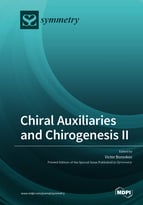Chiral Auxiliaries and Chirogenesis II
A special issue of Symmetry (ISSN 2073-8994). This special issue belongs to the section "Chemistry: Symmetry/Asymmetry".
Deadline for manuscript submissions: closed (30 January 2021) | Viewed by 25746
Special Issue Editor
Interests: sensors; induced chirality; chirality transfer; supramolecular chirality; chiral chromophores; circular dichroism; chiral materials and surfaces
Special Issues, Collections and Topics in MDPI journals
Special Issue Information
Dear Colleagues,
Chirality is one of the most fundamental properties of nature, and is important in different branches of science, technology, and medicine, relating to the ability of any object to exist as a pair of non-superimposable mirror images or to a unidirectional action (e.g., motion). It is widely seen, and plays a key role in various biological structures, such as saccharides, proteins, enzymes, membranes, DNA/RNA, etc. The phenomena of chiral auxiliary and chirogenesis are of paramount significance for all aspects of chirality, and include asymmetry generation, transfer, amplification, modulation, memorizing, and others. The investigation of these effects is a rapidly growing area of research, and directly connects with numerous natural processes, artificial systems, and modern industries. In addition, this research field has important practical implications in novel materials, enantioselective catalysis, chiral sensors, optical resolution, asymmetric synthesis, nanotechnology, medicine, pharmacology, biomimetic studies, and others.
The aim of this Special Issue is to highlight and overview all aspects of chiral auxiliary and chirogenesis in different natural/physical sciences and in modern technologies. All types of papers, including comprehensive reviews on general areas, mini reviews on specialized subjects, accounts of own research work, full experimental or theoretical papers, short communications, technical notes, comments, and others are welcome for consideration.
Dr. Victor Borovkov
Guest Editor
Manuscript Submission Information
Manuscripts should be submitted online at www.mdpi.com by registering and logging in to this website. Once you are registered, click here to go to the submission form. Manuscripts can be submitted until the deadline. All submissions that pass pre-check are peer-reviewed. Accepted papers will be published continuously in the journal (as soon as accepted) and will be listed together on the special issue website. Research articles, review articles as well as short communications are invited. For planned papers, a title and short abstract (about 100 words) can be sent to the Editorial Office for announcement on this website.
Submitted manuscripts should not have been published previously, nor be under consideration for publication elsewhere (except conference proceedings papers). All manuscripts are thoroughly refereed through a single-blind peer-review process. A guide for authors and other relevant information for submission of manuscripts is available on the Instructions for Authors page. Symmetry is an international peer-reviewed open access monthly journal published by MDPI.
Please visit the Instructions for Authors page before submitting a manuscript. The Article Processing Charge (APC) for publication in this open access journal is 2400 CHF (Swiss Francs). Submitted papers should be well formatted and use good English. Authors may use MDPI's English editing service prior to publication or during author revisions.
Keywords
- chirality
- chirogenesis
- chiral auxiliary
- stereochemistry
- asymmetry
- optical activity
- enantiomeric resolution
- chiroptical spectroscopy
- chirality devices






